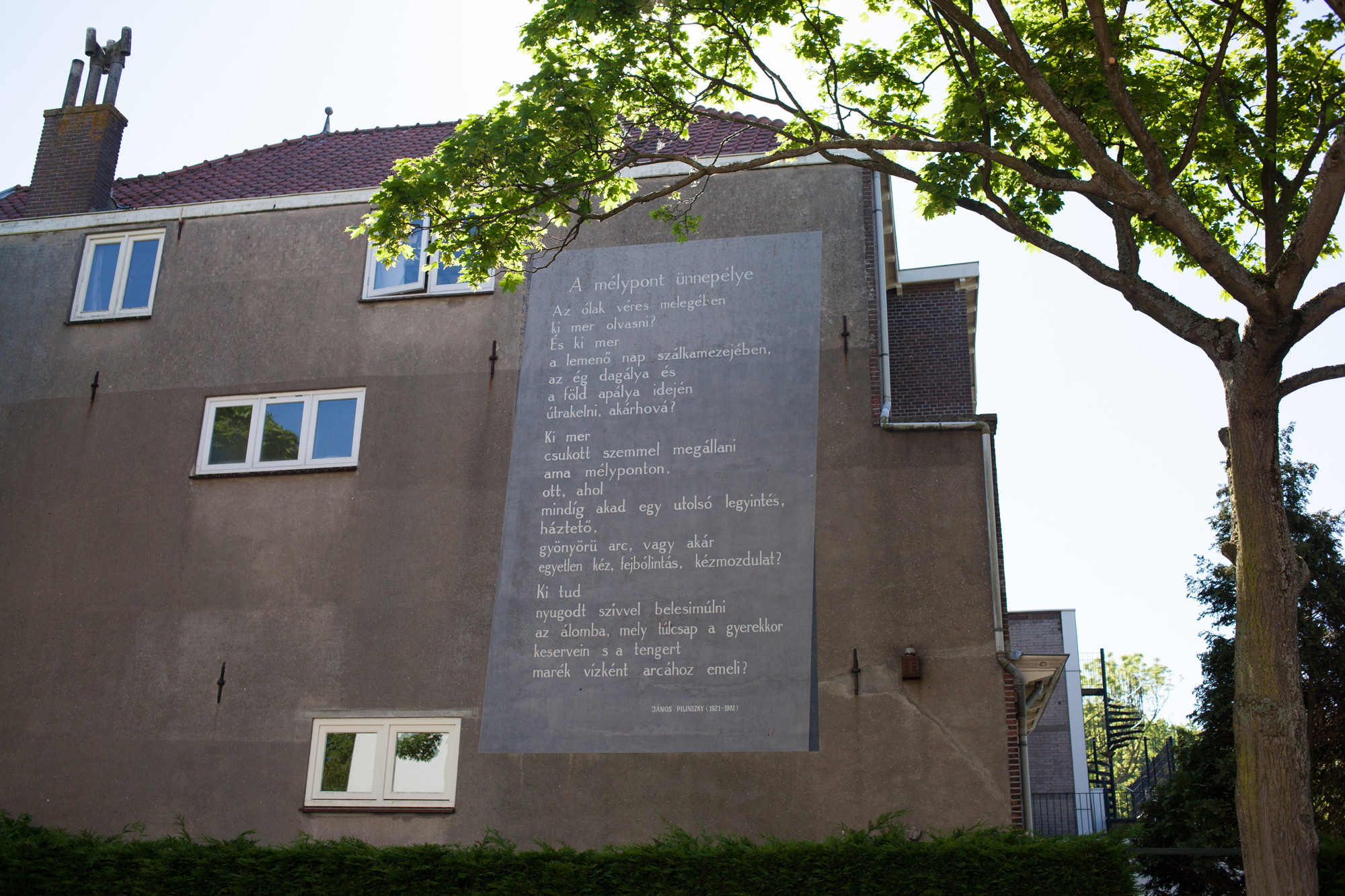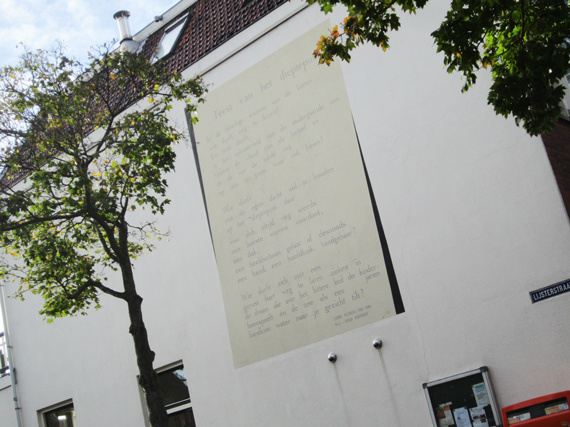Feest van het dieptepunt
In de bloedige warmte van de kotten,
wie durft nog te lezen?
En wie durft
in het splinterveld van de ondergaande zon,
tijdens de vloed van de hemel en
de eb van de aarde nog
op reis te gaan, waar ook heen?
Wie durft
met de ogen dicht stil te houden op het dieptepunt,
daar
waar zich altijd nog weer
een laatste wuiven voordoet,
een dak,
een beeldschoon gelaat of desnoods een hand,
een hoofdknik, handgebaar?
Wie durft zich met een
gerust hart weg te laten zinken in
de droom die over het bittere leed der kinderjaren heenspoelt
en de zee als een
handkom water naar je gezicht tilt?
Vertaling: Erika Dedinszky
Listen to this poem in Hungarian.
Voice: Siebren Ruijg
This poem in 60 seconds
Little can be celebrated at rock bottom, or so it seems. János Pilinszky wonders whether that is actually true. Then where can you still find support and consolation? If texts or travels do not offer comfort, and there is no relief in sight? Answers are not what he seems to offer, but the title might indicate that the situation is not hopeless. The nadir can be celebrated too, because the only possible way is up.
Want to know more? On this website you can listen to the poem, discover its origins and its author and find out what the poem means to the people of Leiden.
János Pilinszky
Budapest 1921 - 1981
János Pilinszky is sometimes considered an atypical Hungarian poet, because he does not use flowery language but rather a sober style. This is, among other things, attributed to his wartime experiences. Pilinszky served in the Hungarian Army during the Second World War and was involved in the liberation of several concentration camps. That experience never left him again.
Poet
Pilinszky grew up in an intellectual family. He wrote his first poems around 1938, but published his first work only after the war. His star rose quickly and in the fifties, he had become one of the most famous Hungarian poets and had won multiple prizes. Although he was restricted by the communist regime, he also rose to fame abroad in the following decades. By the time he died of a heart attack, he had become the most prominent Hungarian post-war poet.
What's this poem about?
In A mélypont ünnepélye (The nadir celebrated), the poet wonders who still dares to dream, still dares to hope when they have reached absolute rock bottom.
Nadir
Pilinszky’s poetry is known for its many implicit references to the war and religion. It is possible that this poem, too, is based on his own wartime experiences. The ‘bloody heat of the sties’ calls up the image of the concentration camp ovens, where the victims of the Nazis were burnt. With those horrors at the back of one’s mind, who can still read the Bible and believe it? Where can you still find consolation?
The way up
When rock bottom is reached, the only way is up. The word ‘celebration’, from ‘celebrate’ in the title, can also be translated as ‘festival’ or ‘ceremony’, in other words: something that people use to give meaning to their lives. The poet mentions all kinds of behavior that seem pointless in light of the nadir, but can contribute to the way up nonetheless.
Origin story
János Pilinszky published this poem in 1972. Little is known about the way Pilinszky created and worked on his poetry. It probably took him several years to write this poem and polish it unremittingly.
Share your story
Does this poem hold a special place in your heart? For example, do you remember when you first read the poem? Or did you come across it someplace unexpected? Let us know at muurgedichten@taalmuseum.nl! We would love to add your story to our website.
János Pilinszky in Leiden

Photo: Anoesjka Minnaard
This wall poem was unveiled on 27 November 2004 at the side wall of Rijnsburgerweg 144, on the corner of Lijsterstraat. It was the 97th wall poem realized by the TEGEN-BEELD Foundation and it was unveiled by Gábor Szentvány, the Hungarian ambassador, accompanied by his cultural attaché. Hungary’s entry into the European Union earlier that year was also addressed.
Design
Of course, the wall poem is in Hungarian. On the opposing wall, the Dutch translation can be found. The typography and color scheme differ slightly between the two versions of the poem. The large surface having two small, differently colored edges creates the impression that we are looking at a pile of paper whose sheets are not lying straightly on top of each other.

Photo: Leo van Zanen
Fun facts
- Some poems by Pilinszky have been set to music and performed, such as KZ-oratórium (Oratorio for a Concentration Camp).
- His poetry is sometimes compared to Gerrit Achterberg’s. Coincidentally, this neighborhood also houses a wall poem of Achterberg’s: Kleine ode aan het water (Modest ode to water).
A mélypont ünnepélye
Az ólak véres melegében
ki mer olvasni?
És ki mer
a lemen? nap szálkamezejében,
az ég dagálya és
a föld apálya idején
útrakelni, akárhová?
Ki mer
csukott szemmel megállani
ama mélyponton,
ott, ahol
mindíg akad egy utolsó legyintés,
háztet,
gyönyörü arc, vagy akár
egyetlen kéz, fejbólintás, kézmozdulat?
Ki tud
nyugodt szívvel belesimúlni
az álomba, mely túlcsap a gyerekkor
keservein s a tengert
marék vízként arcához emeli
Here, you can listen to this poem in Hungarian.
The nadir celebrated
In the bloody heat of the sties
who dares read?
And in the splintered field
of the setting sun,
at earth's ebb
and sky's flow,
who dares set off - anywhere?
Who dares
stand still, eyes closed,
at the nadir,
at the point where
there will always be a last flailing wave,
a roof,
a beautiful face, or even
a single hand, nod, movement of the hand?
Who can
ease himself into sleep
with a satisfied heart,
into sleep that splashes beyond
the bitterness of childhood
and lifts the sea to his face
like a fistful of water?
Translation: Peter Sherwood
Learn more
This entry was written by Het Taalmuseum in collaboration with Siebren Ruijg. The translation into English is by Emma Knapper. The following sources were consulted:
- János Pilinszky, Szálkák [Splinters] (1972).
- Ditto, Krater (Vianen: Kwadraat 1984), prefaced, chosen and translated by Erika Dedinszky.
- The poem, recited by György Orbán at YouTube.
- Background information on this poem and János Pilinszky in this online web log post.
- Biographical information about János Pilinszky at this website.
